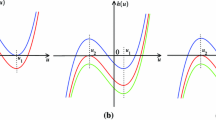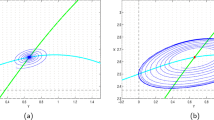Abstract
A dynamical system for optimal path of energy and resources between two cities in China is considered in this paper. We have discussed dynamics of variables and parameters involved in mentioned system. Bifurcation analysis around non-hyperbolic equilibria is also explained for codimension 1 and 2 bifurcations. Furthermore, double-zero eigenvalue condition is calculated for the proposed model. We have adopted methodology of the generalized vectors for existence of Bogdanov–Takens bifurcation critical point and used analytical computations instead of center manifold theorem for Bogdanov–Takens bifurcation around zero equilibria. Further, with the aid of bifurcation diagram, phase portraits and time history, we discussed occurrence of period doubling, Hopf bifurcation and chaotic region of our proposed model. Based on Lyapunov function and robust control, optimal controllers are designed using Hamilton-Jacobi theorem for the stability of disturbance and aperiodic solution in optimal transportation system (3) due to energy imports from city A to city B.














Similar content being viewed by others
References
Algaba A, Dominguez-Moreno MC, Merino M, Rodriguez-Luis A (1998) Analysis of Hopf and Takens–Bogdanov bifurcations in a modified van der pol–duffing oscillator. Nonlinear Dyn 16:369–404
Algaba A, Dominguez-Moreno MC, Merino M, Rodriguez-Luis A (1999) On the Takens–Bogdanov bifurcation in the Chua’s equation. IEICE Trans Fundam Electron Commun Comput Sci 82(9):1722–1728
Algaba A, Dominguez-Moreno MC, Merino M, Rodriguez-Luis A (2015) Takens–Bogdanov bifurcations of equilibria and periodic orbits in the Lorenz system. Commun Nonlinear Sci Numer Simul. https://doi.org/10.1016/j.cnsns.2015.06.034
Bi QS, Yu P (1999) Symbolic software development for computing the normal form of double Hopf bifurcation. Math Comput Model 29:49–70
Chen P, Islam SM (2005) Optimal control models in finance. Springer, Berlin
Ding X, Sinha A (2016) Hydropower plant frequency control via feedback linearization and sliding mode control. J Dyn Sys Meas Control 138(7):0745011–0745015
Dong Y, Li S, Zhang S (2017) Hopf bifurcation in a reaction–diffusion model with Degn–Harrison reaction scheme. Nonlinear Anal Real World Appl 33:284–297
Franke JE, Yakubu AA (2006) Multiple attractors via Cusp bifurcation in periodically varying environments. J Differ Equ Appl 11:365–377
Garfinkel A, Spano ML, Ditto WL, Weiss JN (1992) Controlling cardiac chaos. Science 257:1230–1235
Huang J, Gong y (2013) Bifurcation analysis in a predator-prey model with constant-yield predator harvesting. Discrete Contin Dyn Syst Ser B 18(8):2101–2121
Kuznetsov YA (1998) Elements of applied theory. Springer, New York
Kuznetsov YA (2005) Practicle computation of normal forms on center manifolds at degenerate Bogdanov–Takens bifurcation. Int J Bif Chaos 15(11):3535–3546
Lam J, Tam HK (2004) Robust eigenstructure assignment with minimum subspace seperation. Int J Robust Nonlinear Control 14(15):1227–1253
Li H, Wang M (2013) Hopf bifurcation analysis in a Lorenz-type system. Nonlinear Dyn 71:235–240
Liu X, Liu S (2012) Codimension two bifurcation analysis in two-dimensional Hindmarsh–Rose model. Nonlinear Dyn 67:847–857
Liu Z, Magal P, Xiao D (2016) Bogdanov–Takens bifurcation in a predator–prey model. Z Angew Math Phys 67(137):1–29
Marsden JE, McCracken M (1976) The Hopf bifurcation and its applications. Springer, Berlin
Marwan M, Ahmad S, Aqeel M, Sabir M (2019) Control analysis of rucklidge chaotic system. J Dyn Syst Meas Control 141(4):0410101–0410107
Marwan M, Mehboob M, Ahmad S, Aqeel M (2020) Hopf bifurcation of forced chen system and its stability via adaptive control with arbitrary parameters. Soft Comput 24(6):4333–4341
Sang B, Huang B (2017) Bautin bifurcations of a financial system. Electron J Qual Theory Differ Equ 95:1–22
Shahzad M (2016) Chaos control in three dimensional cancer model by state space exact linearization based on Lie Algebra. Mathematics 33:111–112
Song Z, Xu J (2012) Codimension-two bursting analysis in the delayed neural system with external stimulations. Nonlinear Dyn 67(1):309–328
Song Z, Xu J, Li Q (2009) Local and global bifurcations in an sirs epidemic model. Appl Math Comput 214(2):534–547
Song Z, Xu J, Zhen B (2019) Mixed-coexistence of periodic orbits and chaotic attractors in an inertial neural system with a nonmonotonic activation function. Math Biosci Eng MBE 16(6):6406–6425
Song Z, Zhen B, Hu D (2020) Multiple bifurcations and coexistence in an inertial two-neuron system with multiple delays. Cognit Neurodyn 14:1–16
Soon LT, Salleh Z (2013) Hopf bifurcation analysis of a modified Lorenz system. AIP Conf Proc 1522:158–168
Storac M, Linaro D, de lange E (2008) The Hindmarsh–Rose neuron model: bifurcation analysis and piecewise-linear approximations. Chaos 18:033128
Sui S, Yang J, Zhao L (2019) On the number of limit cycles for generic Lotka–Volterra system and Bogdanov–Takens system under perturbations of piecewise smooth polynomials. Nonlinear Anal Real World Appl 49:137–158
Sun T, Pan Y (2019) Robust adaptive control for prescribed performance tracking of constrained uncertain nonlinear system. J Frankl Inst 356(1):18–30
Sun M, Tian L, Xu J (2006a) Hopf bifurcation analysis of the energy resource chaotic system. Int J Nonlinear Sci 1(1):49–53
Sun M, Tian L, Xu J (2006b) Time-delayed feedback control of the energy resource chaotic system. Int J Nonlinear Sci 1(3):172–177
Sun M, Tian L, Jiang S, Xu J (2007a) Feedback control and adaptive control of the energy resource chaotic system. Chaos Solitons Fractals 32:1725–1734
Sun M, Tian L, Xu J (2007b) An energy resources demand–supply system and its dynamical analysis. Chaos Solitons Fractals 32:168–180
Tam HK, Lam J (2000) Robust deadbeat assignment with gain constraints: an LMI optimization approach. Optim Control Appl Methods 21(6):243–256
Tang Y, Zhang W (2004) Bogdanov–Takens bifurcation of a polynomial differential system in biochemical reaction. Comput Math Appl 48:869–883
Vaidyanathan S (2015a) Adaptive backstepping control of enzymes-substrates system with ferroelectric behaviour in brain-waves. Int J Pharm Tech Res 8:256–261
Vaidyanathan S (2015b) Dynamics and control of Tokamak system with symmetric and magnetically confined plasma. Int J Chem Tech Res 8:795–803
Wang M, Xu H, Sheng Z (2013) A novel three-dimensional energy resources chaotic system with government regulation and empirical research. J Inf Comput Sci 10(15):4879–4892
Wei W, Wang M, Li D, Zuo M, Wang X (2016) Disturbance observer based active and adaptive synchronization of energy resource chaotic system. ISA Trans 65:164–173
Wiggins S (2003) Introduction to applied nonlinear dynamical system and chaos. Springer, New York
Wu X, Chi M (2015) Parameters study of Hopf bifurcation in railway vehicle system. J Comput Nonlinear Dyn 10(3):031012
Wu Y, Hu K, Sun X-M (2018) Modeling and control design for quadrotors: a controlled hamiltonian systems approach. IEEE Trans Veh Technol 67(12):11365–11376
Yang P (2019) Hopf bifurcation of an age-structured prey-predator model with Holling type II functional response incorporating a prey refuge. Nonlinear Anal Real World Appl 49:368–385
Yang SJ, Li CD, Huang TW (2014) Impulsive control and synchronization of memristor-based chaotic circuits. Int J Bifurc Chaos 24(12):145–162
Yui D, Guan ZH, Li J, Liu I, Xiao JW, Ling G (2019) Stability and bifurcation of delay coupled genetic regularity networks with hub-structure. J Frankl Inst 356(5):2857–2869
Acknowledgements
Authors are grateful to Higher Education Commission to support this research under project 5863/Federal/NRPU/R&D/HEC/2016.
Author information
Authors and Affiliations
Corresponding author
Ethics declarations
Conflict of interest
The authors declare that they have no conflict of interest.
Ethical standard
This paper does not contain any studies with human participants or animals performed by any of the author.
Additional information
Communicated by V. Loia.
Publisher's Note
Springer Nature remains neutral with regard to jurisdictional claims in published maps and institutional affiliations.
Rights and permissions
About this article
Cite this article
Marwan, M., Ahmad, S. Bifurcation analysis for energy transport system and its optimal control using parameter self-tuning law. Soft Comput 24, 17221–17231 (2020). https://doi.org/10.1007/s00500-020-05014-3
Published:
Issue Date:
DOI: https://doi.org/10.1007/s00500-020-05014-3




